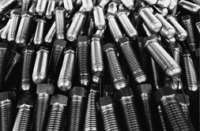Which Zinc Do You Use?
Choosing which zinc baths to install is not as simple as you would think...
As they have been for years, jobshop platers are under pressure to make a choice concerning which zinc baths to install. Sometimes, platers are asked by suppliers of zinc-alloy processes, "Which direction are the requests going? What are your customers asking for?" The typical plater's response is, "I thought you could help us. What is your crystal ball telling you?"
In most cases, platers are just trying to distinguish a unified need on the part of their customers, a need that promises to carry over to future years. Introducing a new bath is a costly proposition, and there is an understandable concern over introducing one that customers are actually interested in using.
Featured Content
The decision process used to be easier. Around 1960, the big decision was zinc versus cadmium. In the late 1960s, the choice was between cyanide and acid zinc. This turned out not to be a hard choice because the acid zinc not only eliminated the need for a cyanide-bearing solution, but improved coverage on castings and forgings.
By the 1980s, the question was more complicated. Now platers had to make installation decisions that involved zinc alloys, zinc-nickel, zinc-cobalt and zinc-iron, as well as the standard established zinc baths. Having been used for more than a decade in Europe and Japan, these zinc-alloy baths were a proven technology. The decision about which ones to install centered mainly on processing volumes that would justify the installation cost.
The new kid on the block. Tin-zinc is not actually new. It has been available to U.S. platers since at least 1950. But only in recent years has tin-zinc become more widely available as a plating option in the U.S.
The British, through the Tin Research Institute, are the leading developers and promoters of tin-zinc technology. Tin-zinc deposits (70 to 80 pct tin) offer good solderability and excellent corrosion resistance, even after forming. Because tin-zinc inhibits the growth of tin whiskers, it works well as an electrical contact. Tin-zinc also resists friction, wear and deterioration from contact with gasoline and brake fluid.
The pros and cons of zinc alloys. Zinc alloys are popular for good reason. Their functional properties give them improved corrosion resistance (as measured by salt spray testing) compared to plating with straight zinc. This improved performance is a direct result of the alloy additions (typically 0.3 to 11 pct), which allow the deposit to remain sacrificial over steel.
The ability to chromate zinc deposits continues to improve, with certain post-plating dips compatible with both zinc and zinc-alloy deposits. It is of special note that chromating increases the salt spray resistance of the initial zinc alloy up to ten times. Chromating of standard zinc roughly doubles the salt spray resistance.
Like all plating baths, the zinc alloys combine both benefits and drawbacks. They are good or not-so-good depending on the application. Here are some considerations:
- Zinc-iron and zinc-cobalt (alkaline) have excellent thickness distribution, but only average covering power;
- Zinc-nickel and zinc-cobalt (acid) have somewhat less thickness distribution, but better covering power, which makes them a good selection for plating malleable, cast and carbonitrided surfaces;
- Zinc-iron has a finish that is both weldable and ductile, making it a good choice for components that will undergo subsequent manufacturing steps, although it deteriorates rapidly when exposed to heat;
- Zinc-nickel is the most ductile zinc alloy, which makes it an excellent choice if forming will take place later, but the nickel content must stay below 14 pct or the deposit will no longer protect the steel in a corrosive environment; and
- Zinc alloys, when applied to fasteners where the torque/tension range is between 340 and 370 inch-lbs, may require a special dip to improve the torque/tension requirements. Also, the brightness is not as high as that produced by the old acid-zinc solutions.
Who is using what? The trend, whenever possible and wherever possible, is to replace cadmium. Zinc alloys are the preferred replacements. The shift from cadmium to zinc makes the automotive industry one of the major users of zinc and zinc-alloy finishes. Zinc-plated components are found in brake systems, fuel systems, chassis hardware and climate control components. Zinc is a key factor, too, in the extended corrosion warranties available from most automotive manufacturers. Instead of parts that withstand 240- to 360-hrs of salt spray testing, parts are now capable of 750 to 1,000 hrs. Zinc and zinc alloys play a central role in such developments.
Other industrial sectors that rely on zinc-alloy processing include manufacturers of hydraulic fittings, power transmission hardware and electronic connectors. Studies on the feasibility of replacing cadmium with zinc nickel are being conducted by government agencies, including the U.S. Navy, U.S. Air Force and FAA. The Air Force studies were prompted by studies conducted by Boeing that show no detrimental galvanic cell when certain zinc-nickel alloys are in contact with aluminum. In addition, heat treatment produces no more degradation in zinc-nickel than it does in cadmium.
Reprinted with permission from Anoplate News, Winter 1998.
RELATED CONTENT
-
Cleaning, Pretreatment to Meet Medical Specs ISO 13485 or FDA 21 CFR820
Maximilian Kessler from SurTec explains new practices for industrial parts cleaning, metal pretreatment and decorative electroplating in the medical device industry.
-
Plating Q&A: Can you color stainless steel?
Our expert, Art Kushner, says yes, you can color stainless steel, but it is not a process that is typically performed in a plating shop. Read more about his answer.
-
Stripping of Plated Finishes
The processes, chemicals and equipment, plus control and troubleshooting.




















